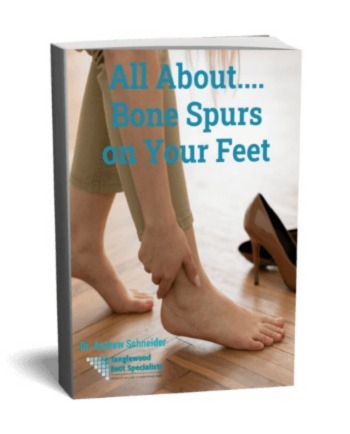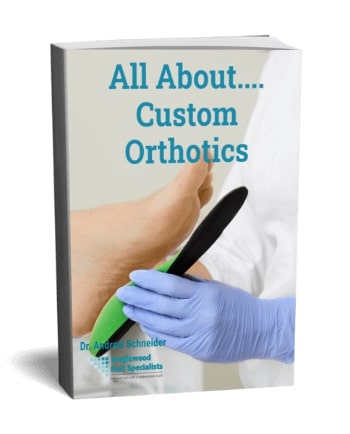
There are many reasons why you develop a bump, lump, or knot on top of your foot. But there are two main causes: bone spurs, or bursas. (These are also called cysts.) Let's look at both!
Bumps on Top of Your Foot: Bone Spurs
I know that a bone spur sounds scary. But it's actually a harmless condition. Basically, a spur is a bony outgrowth that forms on top of other bones. It develops because of pressure.
On their own, bone spurs don't cause problems. Still, they form on other bones. So they can make it painful to wear shoes. And, when your shoes rub against the spur? You may develop inflammation and more discomfort.
What is a Bursa?
If that bump on top of your foot isn't a bone spur? It could form because of soft tissue flare-ups such as a bursa or cyst. Now, you may think that a painful bursa or cyst on top of the foot would be quick and easy to treat, unlike a bone spur. But you need to think again.
Here's the deal. A bursa is a fluid-filled sack that your body creates in response to pressure. (Sounds familiar, right? Your feet don't like pressure. So they have several protective tools they launch in response to that force.)
But where does that pressure come from? It may be external, coming from a tight, pinching shoe. But the pressure could be internal, due to imbalances in your body's biomechanics. And here's where things get even trickier. That bursa may form because of pressure caused by a bone spur beneath it. Are you starting to see why it's tough to treat that bump on top of your foot?
Bursitis on Top of the Foot: A Closer Look
Now you know why that cyst may have formed on your foot. But what's inside it? And can you drain it like a blister?
Well, your bursa contains a thin, watery fluid. But you can't pop it like you may do with a blister. And you certainly can't ignore it. Because, with continued pressure, the tissue will inflame and turn into bursitis.
Bump on Top of Foot: What is a Cyst?
We've already seen the common ground between bone spurs and bursa. (They both form in response to pressure.) But what about cysts? Where do they fit into this picture?
Well, like a bursa, a cyst, such as a ganglion cyst, is also a soft tissue sack that fills with fluid. (When it forms at the end of your toe or hallux, it's called a myxoid cyst, and can involve more complex treatment.) Unlike bursa, these bumps form deeper in the foot. (They often involve a tendon.) Cysts and bursa are both filled with fluid. Yet the fluid in a cyst is much thicker and more viscous. And this thick fluid makes it more difficult to drain a cyst than a bursa. Now, activity can cause your cyst to grow larger, so it's important to seek treatment if you want to maintain a running program or other forms of physical activity.
Diagnosing and Treating Top of Foot Bumps in Houston, TX
In my Houston podiatry office, I know how important it is to treat painful bumps, lumps, and knots on your foot. So, when you come in, I will first identify what is causing the bump on your foot. Then, we can get to treating the lump.
If you have a bone spur, you probably won't need much treatment. I may recommend shoe changes or padding to prevent pain and inflammation. If you're already very uncomfortable, I may suggest over-the-counter NSAIDs to relieve pain and inflammation. But what if you have a fluid-filled soft tissue bump?
After your exam, if it's appropriate, I'll drain the cyst or bursa, usually by making a small puncture within the bump. At that point, your body may or may not cause it to return. But, as you may have guessed, these bumps like to come back. So we'll also want to take measures to stop that from happening.
Prevention: Keep that Bump on Top of Foot From Coming Back ![bump on top of foot]()
After initial treatment, there are measures we can take to try to prevent the bump on top of your from returning. For instance, using cortisone in the bump after it is drained may help. For some patients, cauterizing the drained cyst could keep it from coming back. And using a compressive dressing will also help prevent the bump's return.
Unfortunately, there are times when draining your bursa or cyst isn't enough to solve the problem for good. Sometimes, we'll need to remove a cyst or underlying bone spur with foot surgery.
Other times, the process takes patience. We simply may need to repeatedly drain your bumps, while modifying the pressure from the shoes. In some cases, that could involve changing shoe style or even shoe size. (Did you know your feet can change sizes as you age? If your feet haven't been measured in a while, you could be cramming your foot into a shoe that's too small. And that could be painful.)
Other times, it will mean switching up your shoe lacing technique to accommodate the bump on your foot. Or, in certain instances, it will mean resolving internal pressure with the use of custom orthotics. Because, if the pressure results from mechanical imbalances in your feet, that bursa will keep coming back until we offer support with these custom medical devices.
Will the Bump on Top of my Foot Keep Coming Back Forever?
By now, you can tell that getting rid of the painful lump on top of your foot may be challenging. I wanted to be clear about that, so that you know the treatment path you'll face with me. But I don't want you to despair. Or resign yourself to foot surgery. Because here's the bottom line.
When you come to see Houston podiatrist Dr. Andrew Schneider, I will help you find relief. I will first evaluate the bump, lump, or knot on top of your foot. Then, I'll advise you about the best treatment. And the best follow-up, preventative care to keep your lump from coming back.
Will the process take a while? It very well might. And it may end in surgery, if less invasive options simply aren't working. But guess what? I'll be with you every step of the way, keeping you comfortable and taking measures to keep that lump on your foot from causing you problems. Ready to get started? Contact Tanglewood Foot Specialists for an immediate appointment.





















